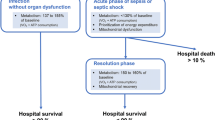Summary
In recent times our understanding of metabolism at the biochemical and subcellular level has increased. It is now apparent that an understanding of the causes and mechanism of the inflammatory response to sepsis is vital to the management of this condition. The systemic inflammatory response in sepsis disrupts the normal homeostatic processes and can progress to multiple organ failure and death.
Increased metabolic rate as a result of sepsis causes a characteristic hypocaloric and hypoproteinaemic malnutrition. Specific amino acids are necessary for the synthesis of proteins and vasoactive peptides and for the functioning of macrophages and leucocytes. In addition, arginine, glutamine, omega-6-fatty-acids and nucleotides are required for adequate immune function. Thus, adequate nutritional support can greatly influence outcome in patients with sepsis.
Since the adverse sequelae of sepsis result from the neuroendocrine inflammatory response, nonsteroidal anti-inflammatory drugs have therapeutic potential in this condition. In the future, monoclonal antibodies to bacterial endotoxins are expected to limit the inflammatory response to endotoxins produced by Gram-negative bacteria.
Similar content being viewed by others
References
Alexander JW, Gottschlich MM. Nutritional immunomodulation in burn patients. Critical Care Medicine 18 (Suppl. 2): S149–S153, 1990
Bistrian BR. A simple technique to estimate severity of stress. Surgery Gynecology and Obstetrics 148: 675–678, 1979
Bone RC, Fisher CJ, Clemmer TJ, et al. Sepsis syndrome: a valid clinical entity. Critical Care Medicine 17: 389, 1989
Border JR, Hassett J, LaDuca J, Seibel R, Steinberg S, et al. The gut origin septic states in blunt multiple trauma (ISS=40) in the ICU. Annals of Surgery 206: 427–448, 1987
Carrico CJ, Meakins JL, Marshall JC, Fry D, Maier RV. Multiple-organ-failure syndrome. Archives of Surgery 121: 196–208, 1986
Chandra RK. Effects of overnutrition on immune responses and risk of disease. In Chandra RK (Ed.) Contemporary issues in clinical nutrition. II. Nutrition and immunology, pp. 315–328, Alan R. Liss Inc., New York, 1988
Chauundry IH, Baeu AE. Pathophysiology of shock, anoxia and ischemia. In Overview of haemorrhagic shock, Williams and Wilkins, Baltimore, 1982
Chernow B, Roth BL. Pharmacologic manipulations of the peripheral vasculature in shock: clinical and experimental approaches. Circulatory Shock 19: 393–407, 1986
Chiu CJ, Scott HJ, Gurd FN. Intestinal mucosal lesion in low-flow states. II. The protective effect of intraluminal glucose as energy substrate. Archives of Surgery 101: 484–488, 1970
Christou NV. Introduction. Clinical Therapeutics 12 (Suppl. B): 1, 1990
Dinarello CA. An update on human interleukin-1: from molecular biology to clinical relevance. Journal of Clinical Immunology 5: 287–297, 1985
Fanslow WC, Kulkarni AD, Van Buren CT, Rudolph FB. Effect of nucleotide restriction and supplementation on resistance to experimental murine candidiasis. Journal of Parenteral and Enteral Nutrition 12: 49–52, 1988
Guyre PM, Morganelli PM, Miller R. Recombinant immune interferon increases immunoglobulin G Fc receptors on cultured human mononuclear phagocytes. Journal of Clinical Investigation 72: 393, 1983
Harris RL, Musher DM, Bloom K, Gathe J, Rice L, et al. Manifestations of sepsis. Archives of Internal Medicine 147: 1895–1906, 1987
Levine GM, Deren JJ, Steiger E, Zinno R. Role of oral intake in maintenance of gut mass and disaccharide activity. Gastroenterology 67: 975–982, 1974
MacLean LLD, Meakins JL, Taguchi K, Duignan KS, Gordon DJ. Host resistance in sepsis and trauma. Annals of Surgery 182: 207–217, 1975
Meakins JL, Pietsch JB, Bubenick O, Kelly BA, Rode H et al. Delayed hypersensitivity. Annals of Surgery 186: 241–250, 1977
Meakins JL, Wicklund B, Forse RA, McLean AP. The surgical intensive care unit: current concepts in infection. Surgical Clinics of North America 60: 117–132, 1980
Mullen JL, Gertner MH, Buzby GP, Goodhart GL, Rosato EF. Implications of malnutrition in the surgical patient. Archives of Surgery 144: 121, 1978
Petrark RA, Balk RA, Bone RC. Prostaglandins, cyclo-oxygenase inhibitors and thromboxane synthetase inhibitors in the pathogenesis of multiple systems organ failure. Critical Care Clinics 5: 303–314, 1989
Pomposelli JJ, Flores EA, Bistrian BR. Role of biochemical mediators in clinical nutrition and surgical metabolism. Journal of Parenteral and Enteral Nutrition 12: 212–218, 1988
Repine JE, Bowman CM, Tate RM. Neutrophils and lung edema: state of the art. Chest 81 (Suppl.): 47, 1982
Root RK, Jacobs R. Septicaemia and septic shock. In Harrison’s principles of internal medicine 12th ed., pp. 502–507, McGraw-Hill, 1991
Schumaker PT, Samsel RW. Oxygen delivery and uptake by peripheral tissues: physiology and pathophysiology. Critical Care Clinics 5: 255–269, 1989
Souba WW, Wilmore DW. Gut-liver interaction during accelerated gluconeogenesis. Archives of Surgery 120: 66–70, 1985
Trunkey DD. The treatment of sepsis and other complications in the trauma patient. Clinical Therapeutics 12 (Suppl. B): 21–33, 1990
Villazon A, Terrazas F. Digestive tract in the severity patient. Cirugia y Cirujanos 3: 58, 1991
Villazon SA. Energetic basal expenditure in surgery. Revista Mexicana de Gastroenterologia 13: 29–36, 1987
Villazon SA, Terrazas EF. Calorimetria indirecta. In press, 1992
Walker ML. Nutritional management in the trauma patient. Contemporary Surgery 31: 24–27, 1987
Author information
Authors and Affiliations
Rights and permissions
About this article
Cite this article
Villazon-Sahagun, A., Terrazas, E.F. & Raña, R. Advances in the Understanding and Treatment of Metabolic and Organic Failure in Sepsis. Drug Invest 4 (Suppl 2), 41–48 (1992). https://doi.org/10.1007/BF03258356
Published:
Issue Date:
DOI: https://doi.org/10.1007/BF03258356




